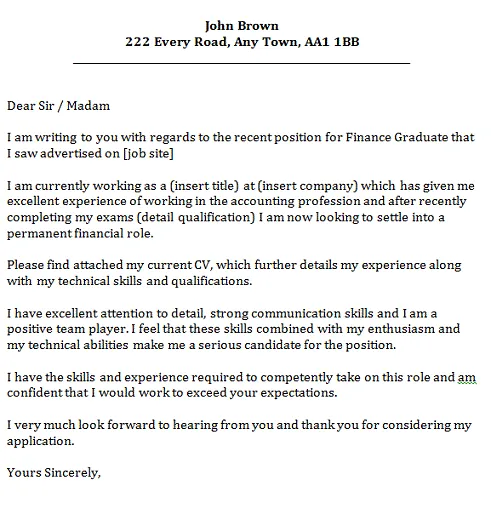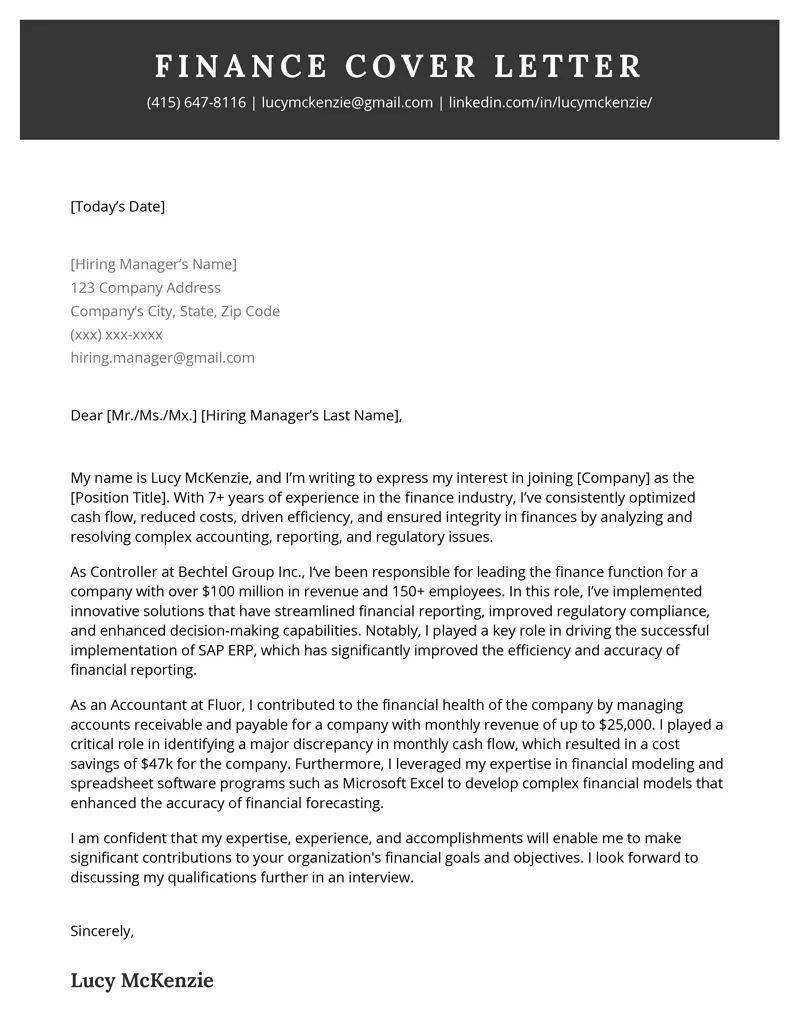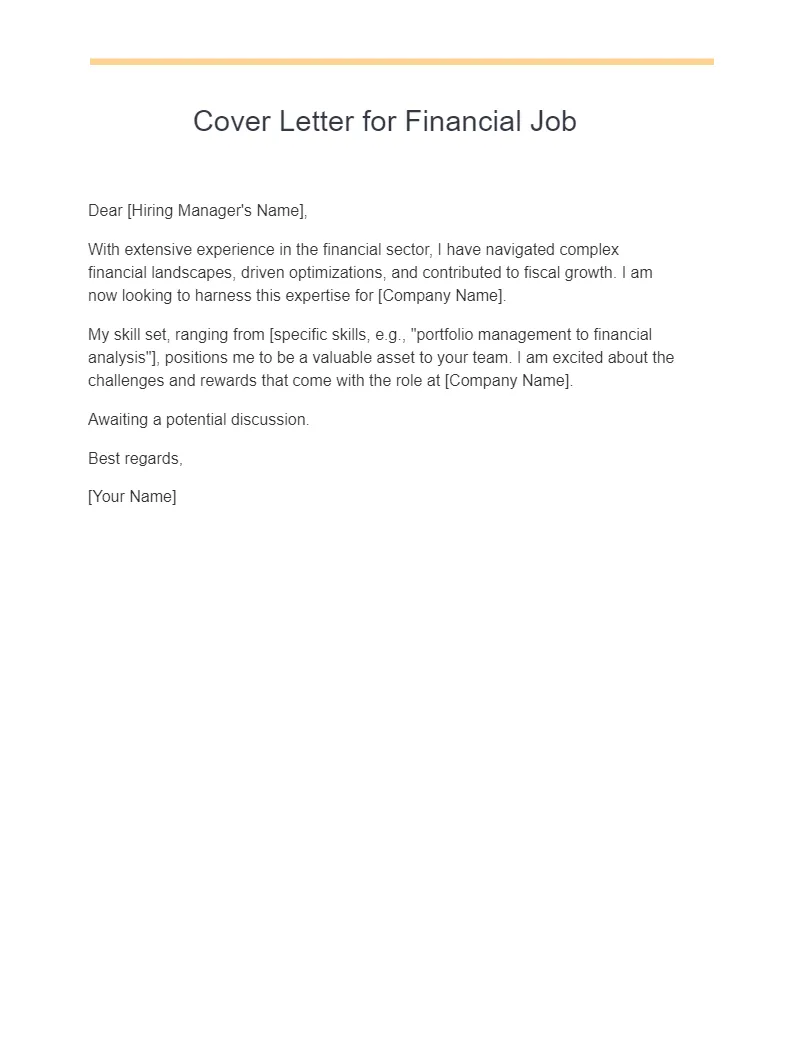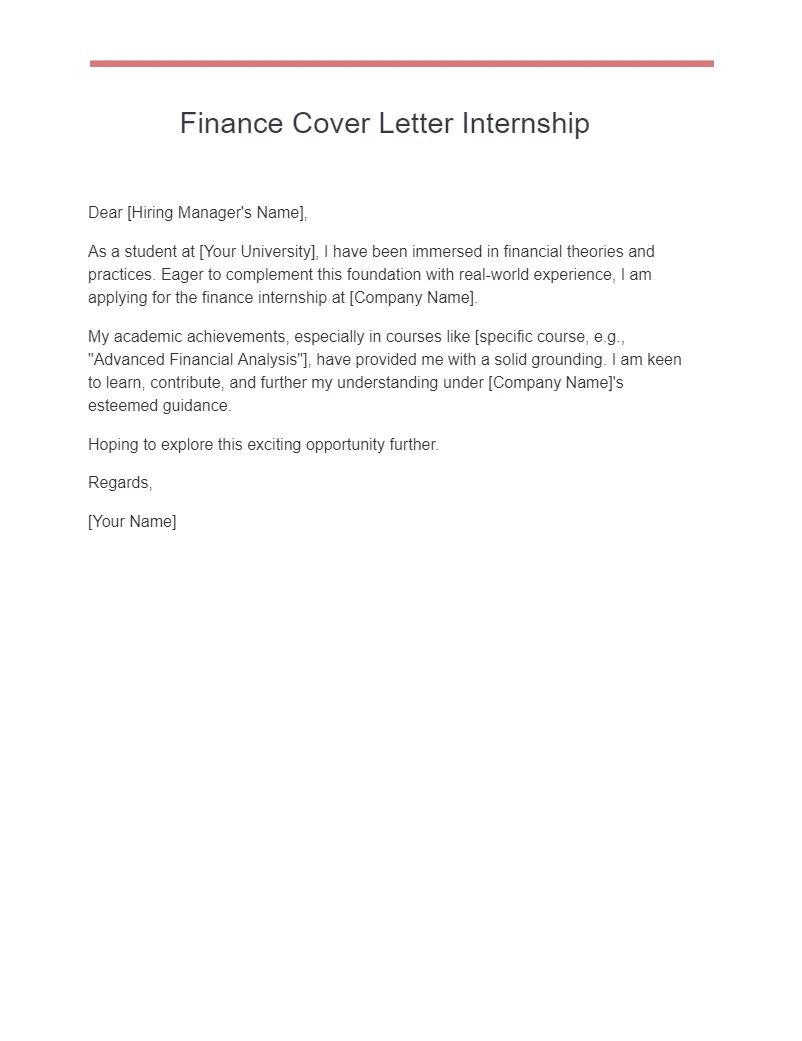The Power of a Finance Cover Letter
In the competitive world of finance, a well-crafted cover letter can be your golden ticket to securing an interview. It’s not just a formality; it’s your opportunity to make a compelling first impression and demonstrate your suitability for the role. A strong cover letter goes beyond simply reiterating your resume; it tells a story, showcasing your personality, passion, and how your skills align with the company’s needs. In the finance sector, where precision and attention to detail are paramount, your cover letter is a direct reflection of your professional capabilities. It provides a platform to elaborate on your experiences, highlight your achievements, and explain why you’re the ideal candidate for the position. Without one, your resume might just blend in with the rest, but with a well-written cover letter, you can immediately stand out and grab the hiring manager’s attention.
Understanding the Purpose of a Cover Letter
The primary goal of a finance cover letter is to introduce yourself and articulate your interest in a specific job, but also to clarify why you are the best fit. It allows you to expand on your resume, providing context and detail that a bulleted list cannot convey. The cover letter lets you demonstrate your understanding of the company’s needs, the role’s requirements, and how your skills and experiences align with both. This proactive approach shows initiative and genuine interest. In a field as detail-oriented as finance, the cover letter is also an opportunity to showcase your professionalism and communication skills. Your writing style, clarity, and the way you structure your thoughts reflect your attention to detail, a critical attribute in finance. Moreover, the cover letter reveals your personality and passion, setting you apart from other applicants. It’s your chance to leave a lasting impression, making the hiring manager eager to learn more about you during an interview.
Key Components of a Finance Cover Letter

A powerful finance cover letter follows a specific structure to effectively convey your qualifications. It starts with your contact information, followed by the hiring manager’s details, if available. The opening paragraph should immediately state the position you’re applying for and express your enthusiasm. The main body should highlight your relevant experience and quantifiable achievements, demonstrating how you’ve added value in past roles. This is where you showcase your skills and tailor your letter to the job description, addressing the specific requirements listed. Then, show your understanding of the company and how your goals align with its mission. Conclude with a closing paragraph that re-emphasizes your interest and includes a clear call to action, such as expressing your availability for an interview. Before submitting, meticulous proofreading and formatting are crucial to ensure a polished and professional presentation.
Your Contact Information
Begin your cover letter by including your full name, phone number, email address, and optionally, your LinkedIn profile URL. This information should be placed at the top of the letter, typically aligned to the left or right. Ensure that your email address is professional and appropriate for the finance industry; avoid using nicknames or informal addresses. Double-check that your contact information is accurate, so the hiring manager can easily reach you. Keeping this section concise and easy to read helps to make a great first impression.
Hiring Manager’s Details
If possible, find the name and title of the hiring manager, and include it as part of the address block, directly below your contact information. Addressing your letter to a specific person shows that you’ve done your research and that you are detail-oriented. Use the correct title (Mr., Ms., Dr.) and spell the name accurately. If you are unable to find the hiring manager’s name, use a general greeting like ‘Dear Hiring Manager’ or ‘Dear [Company Name] Hiring Team’ is a suitable alternative. This personalization can set your cover letter apart from generic applications.
The Opening Paragraph

The opening paragraph is your chance to make a strong first impression. State the specific position you are applying for and how you found the job opening. Show enthusiasm by briefly mentioning something that attracted you to the role or the company. Make it clear why you are interested in the position and the company, and what you have to offer. Keep this section concise but engaging. It is key to capturing the hiring manager’s interest from the start. For example, you could state your interest in the role and your qualifications in a single sentence, followed by a brief, compelling statement about why you are a great fit.
Highlighting Your Experience
The main body of your cover letter should focus on highlighting your relevant experience and skills. Select experiences that directly relate to the job description and explain how your responsibilities and accomplishments align with the position’s requirements. Don’t just list your duties; instead, provide context and explain the impact of your work. Use specific examples and quantify your achievements whenever possible. This could involve mentioning projects you’ve led, processes you’ve improved, or results you’ve achieved. This helps the hiring manager see the value you can bring to their team. This level of detail demonstrates your ability to perform the job successfully.
Quantifying Achievements
In finance, numbers speak volumes. Whenever possible, quantify your achievements to demonstrate your impact. Instead of saying you ‘improved efficiency,’ state that you ‘reduced processing time by 15%.’ Use metrics to show your accomplishments, such as ‘managed a portfolio of $X million,’ ‘increased revenue by Y%,’ or ‘decreased expenses by Z%.’ These concrete figures provide tangible evidence of your skills and effectiveness. This also emphasizes your ability to generate and interpret financial data. Including quantifiable achievements makes your cover letter more compelling and shows the hiring manager what you can deliver.
Showcasing Skills

Clearly showcase your relevant skills in the cover letter. These should include both technical skills and soft skills. Technical skills might involve proficiency in financial modeling, budgeting, forecasting, or specific software like Excel, SAP, or Bloomberg Terminal. Soft skills are equally crucial, such as analytical thinking, problem-solving, communication, and teamwork. Highlight the skills that are most relevant to the job description and provide specific examples of how you’ve utilized them in the past. For instance, describe a situation where you used your analytical skills to solve a complex financial problem. By providing concrete examples, you will show the hiring manager that you have the skills required to succeed in the role.
Tailoring to the Job Description
The key to a successful cover letter is customization. Tailor your letter to each job application by carefully reviewing the job description. Identify the key skills, experience, and qualifications that the employer is seeking. Customize your letter to match these requirements, highlighting the relevant aspects of your background. Show the employer that you have read the job description carefully and that you understand the needs of the role. By showing that you match their needs, you significantly increase your chances of getting an interview. Demonstrating that you have tailored your application to their specific needs is a sure way to impress the hiring manager.
Addressing Specific Requirements
Address each specific requirement listed in the job description. If the job posting asks for experience with a specific software or a certain type of financial analysis, make sure to address these points directly. Provide specific examples of how you have met these requirements in your previous roles. When addressing specific requirements, be clear, concise, and provide concrete evidence of your abilities. Do not simply list the requirements; elaborate on how you have met them and what the outcomes were. By thoroughly addressing each requirement, you demonstrate your attention to detail and your suitability for the position.
Demonstrating Company Fit

Show your knowledge of the company and explain why you want to work there. Research the company’s mission, values, recent projects, and industry standing. Mention how your goals align with the company’s objectives. This could include discussing specific products or services that appeal to you, or referencing the company’s culture. Explaining what resonates with you at the company shows that you’re genuinely interested and invested in their success. This level of research and understanding indicates that you are serious about the opportunity. Demonstrate that you are looking beyond the job itself. Highlighting this point can make your cover letter more memorable and impactful.
The Closing Paragraph
Conclude your cover letter with a strong closing paragraph. Reiterate your interest in the position and express enthusiasm for the opportunity. Clearly state your availability for an interview and provide your contact information once more. Thank the hiring manager for their time and consideration. Avoid generic phrases; instead, make your closing paragraph personal and memorable. A well-crafted closing paragraph reinforces your interest and makes it easier for the hiring manager to take the next step. This can be as simple as stating your eagerness to discuss your qualifications further and thanking them for considering your application.
Expressing Enthusiasm and Call to Action
In your closing paragraph, express your genuine enthusiasm for the opportunity. Show the hiring manager that you’re excited about the prospect of joining their team. Include a clear call to action, such as requesting an interview. Make it easy for them to contact you by including your phone number and email address. This proactive approach shows your eagerness to move forward in the hiring process. By adding a call to action, you guide the hiring manager toward the next step, making it easier for them to make a decision. Make sure you tailor this to reflect the specific job and show why you want to work with them.
Proofreading and Formatting

Thorough proofreading and professional formatting are essential for making a positive impression. Your cover letter is a reflection of your attention to detail, which is highly valued in finance. Use a clean and professional font, such as Times New Roman or Arial. Ensure your letter is free of grammatical errors, typos, and spelling mistakes. Format the letter to be easy to read, with clear spacing and appropriate margins. Poor formatting and errors can undermine your qualifications and diminish your chances. Proofreading and formatting are crucial steps to ensure your cover letter is polished and professional.
Essential Formatting Tips
Use a standard business letter format with your contact information, the hiring manager’s details, and the date. Keep the letter to one page to make it easy to read. Use a professional font such as Times New Roman or Arial, with a font size between 10 and 12 points. Use single spacing within paragraphs and double spacing between paragraphs. Align the text to the left, except for your contact information and the date, which can be right-aligned or centered. Use clear headings and subheadings to break up large blocks of text and make your letter easy to scan. These formatting tips enhance readability and professionalism, making your cover letter more effective.
Proofreading for Accuracy
Proofread your cover letter carefully for any errors in grammar, spelling, and punctuation. These errors can make you look unprofessional and diminish your credibility. Read the letter aloud to catch any awkward phrasing or sentences that don’t flow well. Have a friend, family member, or career advisor review it for you to get a fresh perspective. Using proofreading tools, such as Grammarly, can also help. Proofreading is essential to avoid making a negative first impression. Checking the letter thoroughly ensures that your qualifications and enthusiasm come across as intended.
Final Thoughts and Next Steps

Writing a powerful finance cover letter requires careful planning, attention to detail, and a strategic approach. By following these guidelines, you can create a cover letter that highlights your skills and experience, demonstrates your enthusiasm, and increases your chances of landing an interview. Always tailor your cover letter to the specific job description. After completing your cover letter, the next step is to start applying and stay proactive. Tailor your cover letter to the specific role and company, and carefully proofread it before submitting. Taking these steps increases your likelihood of success, leading to new opportunities in the field of finance. Good luck in your job search!
